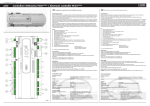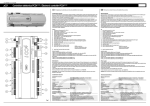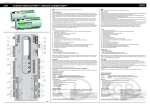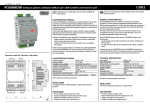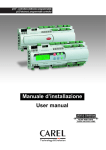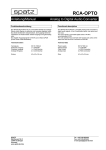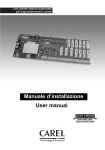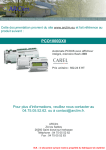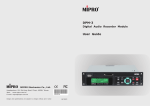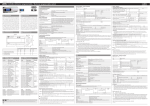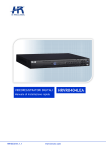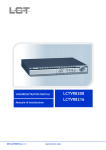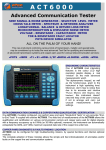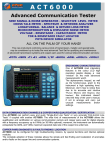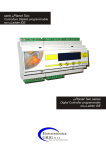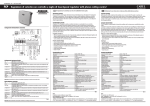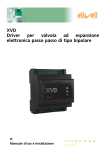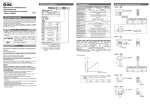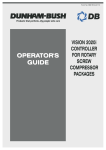Download +05_3220 • pCO1 rel.1.3 (I-GB)
Transcript
cod. +050003220 rel. 1.3 - 14.09.2004 pCO1 Controllore elettronico PCO1**** / Electronic controller PCO1**** Vi ringraziamo per la scelta fatta, sicuri che sarete soddisfatti del vostro acquisto. 1 J1 +5V Rif G GND G0 J9 10 +V Term 2 Fuse J10 11 Rx-/TxRx+/Tx+ B1 J2 B2 B3 B5 4 J3 GND B6 Programming Key +VDC 12 17 Clock card B4 Analog Selection 3 15 J11 GND 13 GND C1 6 NO1 NO2 VG NO3 VG0 7 J4 Y1 Y3 Y4 ID1 ID2 ID3 8 J5 ID4 ID5 16 C1 C4 Serial Card Y2 J12 NO4 NO5 J13 NO6 C4 C7 NO7 J14 ID8 IDC1 NO8 C8 J15 J6 GND ID9 8 J7 ID10 ID11 C9 NO9 NO10 J16 NO11 C9 ID12 IDC9 ID13H 9 J8 ID13 IDC13 General features pCO1 è un controllore elettronico a microprocessore, sviluppato da CAREL per molteplici applicaz. nel settore del condizionamento dell'aria e della refrigerazione. Assicura la più assoluta versatilità di applicazione, consentendo di realizzare prodotti specifici su richiesta del cliente. pCO1 è dedicato all'esecuzione del programma di regolazione ed è dotato del set di morsetti necessari alla connessione verso i dispositivi controllati (ad esempio: valvole, compressori, contattori di potenza, ventilatori). Il programma e i parametri sono memorizzati su FLASH-MEMORY, consentendo il loro mantenimento anche in caso di mancanza di alimentazione (senza la necessità di una batteria di mantenimento). Il caricamento del programma può essere eseguito a mezzo PC o tramite apposita chiave di programmazione. pCO1 permette anche la connessione alla rete locale pLAN (pCO Local Area Network) già prevista per i modelli precedenti di controllori pCO e pCO2. La rete pLAN è costituita da più controllori e più terminali, che interagiscono tra loro. Ogni controllore in rete pLAN può scambiare informazioni (qualsiasi variabile, digitale o analogica, a seconda del programma applicativo utilizzato) con velocità di trasmissione elevata. Possono essere collegate fino a 32 unità, tra pCO1 e terminali, in modo da condividere le informazioni in tempi molto brevi. Il collegamento verso la linea seriale di supervisione/teleassistenza secondo lo standard RS485, viene realizzato tramite l'inserimento sul pCO1 di schede seriali opzionali con il protocollo di comunicazione CAREL o MODBUS™. pCO1 is an electronic controller based on a microprocessor designed by CAREL for a wide range of applications in the Air-Conditioning and Refrigeration sectors. pCO1 is a flexible controller, which can respond to all customer requirements. pCO1 carries out the regulation program and it is fitted with a set of terminals that connect it to the controlled devices (for ex. valves, compressors, power contactors, fans). The program and the parameters are stored on FLASH-MEMORY, thus allowing their permanence even in case of power failure (it is not necessary for you to have a maintenance battery). The program can be loaded through PC or by means of a suitable programming key. pCO1 allows the connection to the local pLAN network (pCO Local Area Network) - already provided in the previous versions of the pCO and pCO2 controllers. The pLAN network is made up of several controllers and terminals which interact among themselves. Every controller in the pLAN network can exchange information (any digital and analog variable according to the used application program) at high transmission speed. In order to rapidly exchange information, up to 32 units - pCO1 and terminals - can be connected to the pLAN network. The connection towards the supervising/telemaintenance serial line, according to the RS485 standard, is carried out by inserting the optional serial cards on the pCO1 with the CAREL standard communication protocol or MODBUS™. Legenda 1. connettore per l’alimentazione [G (+), G0 (-)] 2. fusibile 250 Vac, 2 A ritardato (T2 A) 3. ingressi analogici universali NTC, 0…1 V, 0…5 V, 0…20 mA, 4…20 mA 4. ingressi analogici passivi NTC e ON/OFF 5. ingressi analogici passivi NTC 6. LED giallo indicazione presenza tensione di alimentazione e 3 LED di segnalazione 7. uscite analogiche 0…10 V e uscite PWM taglio di fase 8. ingressi digitali a 24 Vac/Vdc 9. ingressi digitali 230 Vac o 24 Vac/Vdc 10. connettore con Vrif per alimentazione sonde 5 V raziometrici e V Term per alimentazione terminale 11. connettore per tutti i terminali standard della serie pCO* e per il download del programma applicativo 12. connettore rete locale pLAN 13. connettore per la connessione alla chiave per la programmazione 14. uscite digitali a relè 15. sportello per selezione tipo di ingressi analogici 16. sportello per l’inserimento della scheda seriale: - RS485 per supervisore - RS232 per l’interfacciamento modem - Gateway (convertitore di protocollo) 17. sportello per l’inserimento della scheda orologio Key 1. 2. 3. 4. 5. 6. 7. 8. 9. 10. 11. 12. 13. 14. 15. 16. Versioni disponibili: • SMALL (cod. PCO1000AS0), MEDIUM (cod. PCO1000AM0) • SMALL (cod. PCO1002AS0), MEDIUM (cod. PCO1004AM0) con uscite digitali a relè a stato solido (SSR) • SMALL (cod. PCO1000CS0), MEDIUM (cod. PCO1000CM0) versione con memoria espansa Kit connettori: • SMALL (cod. PCO1CON0S0), MEDIUM (cod. PCO1CON0M0) a vite • SMALL (cod. PCO1CON1S0, MEDIUM (cod. PCO1CON1M0) a molla Available models: • SMALL (cod. PCO1000AS0), MEDIUM (cod. PCO1000AM0) • SMALL (cod. PCO1002AS0), MEDIUM (cod. PCO1004AM0), with solid status relay digital outputs (SSR) • SMALL (cod. PCO1000CS0), MEDIUM (cod. PCO1000CM0) expanded memory version Connectors kit: • SMALL (cod. PCO1CON0S0), MEDIUM (cod. PCO1CON0M0) screw • SMALL (cod. PCO1CON1S0, MEDIUM (cod. PCO1CON1M0) spring Alimentazione Power supply Nell’installazione si deve utilizzare un trasformatore di sicurezza in Classe II di almeno 40 VA, per l’alimentazione di un solo controllore pCO1. Si raccomanda di separare l’alimentazione del controllo pCO1 e terminale (o più pCO1 e terminali) dalla alimentazione del resto dei dispositivi elettrici (contattori ed altri componenti elettromeccanici) all’interno del quadro elettrico. Qualora il secondario del trasformatore sia posto a terra, verificare che il conduttore di terra sia collegato al morsetto G0. Attenersi a ciò per tutti i dispositivi connessi al pCO1. Se si alimentano più schede pCO1 collegate in rete pLAN, assicurarsi che siano rispettati i riferimenti G e G0 (il riferimento G0 deve essere mantenuto per tutte le schede). In caso di utilizzo della rete pLAN, richiedere il manuale pCO1 CAREL. During installation a safety Class II transformer rated at least 40 VA must be used to supply only one pCO1 controller. It is advisable to keep separate the pCO1 controller and terminal (or more pCO1 and terminals) from the power supply of the other electric devices (contactors and other electromechanical components) in the electric panel. If the transformer secondary winding is grounded, check that the ground cable is connected to G0 terminal. If more than one pCO1 board, connected to the pLAN, must be powered, please check if G and G0 references are observed (G0 reference must be kept in every board). If using the pLAN network, ask for the CAREL pCO1 user’s manual. power supply connector [G (+), G0 (-)] 250 Vac, 2 A delayed fuse (T2 A) universal analog inputs NTC, 0 to 1V, 0 to 5V, 0 to 20mA, 4 to 20mA passive analog inputs NTC and ON/OFF passive analog inputs NTC yellow LED showing power supply voltage and 3 signalling LEDs analog outputs 0 to 10V and PWM phase-cutting outputs 24 Vac/Vdc digital inputs 230 Vac or 24 Vac/Vdc digital inputs connector with Vrif for the power supply of the 5 V ratiometric probes and V Term for the terminal power supply connector for all pCO* series standard terminals and for the application program download pLAN local network connector connector for the connection to the programming key relay digital outputs hatch for selecting the type of the analogical inputs hatch for inserting the serial card: - RS485 for the supervisor - RS232 for the modem interface - Gateway (protocol converter) 17. hatch for inserting the clock card Ulteriori specificazioni e notizie si possono reperire sul manuale di installazione - cod. +030221840. Further information can be found in the installation manual - code +030221840. AVVERTENZA: il pCO1 (come il pCO2) non può alimentare i terminali grafici PCOT00PGH0 e PCOI00PGL0, che devono quindi essere alimentati con altre sorgenti. WARNING: pCO1 (as pCO2)can not supply the graphic terminals PCOT00PGH0 and PCOI00PGL0, which can be supplied by other sources. Caratteristiche tecniche Technical Specifications montaggio GND B8 Caratteristiche generali Caratteristiche meccaniche dimensioni NC8 B7 5 Thank you for your choice. We trust you will be satisfied with your purchase. C7 ID6 ID7 GB NO12 C12 J17 NC12 14 NO13 ID14 C13 ID14H NC13 J18 Fig. 1 versione SMALL inseribile su 13 moduli DIN, 110 x 227.5 x 60 mm versione MEDIUM inseribile su 18 moduli DIN, 110 x 315 x 60 mm su guida DIN Mechanical Specifications dimensions SMALL board models can be mounted on 13 DIN modules, 110x227.5x60mm MEDIUM board models can be mounted on 18 DIN modules, 110x315x60mm on DIN rail mounting Contenitore plastico materiale tecnopolimero autoestinguenza V0 (secondo UL94) e 960 °C (secondo IEC 695) prova biglia 125 °C resistenza alle correnti striscianti 250 V colore grigio RAL7035 agganciabile su guida DIN secondo norme DIN 43880 e CEI EN 50022 feritoie di raffreddamento Plastic case material technopolymer self-extinguishing V0 (complying with UL94) and 960 °C (complying with IEC 695) ball pressure test 125 °C comparative tracking index 250 V colour RAL7035 grey it can be fastened on DIN rail according to DIN 43880 and CEI EN 50022 standards cooling vent-holes Caratteristiche elettriche alimentazione (controllore con term. connesso) morsettiera Electrical specifications power (controller with terminal connected) terminal block CPU memoria programma (su FLASH MEMORY) memoria dati (RAM statica) memoria dati parametri durata ciclo utile (applicazioni media complessità) 22…38 Vdc e 24 Vac ±15% 50/60 Hz - assorbimento massimo P= 13 W con connettori maschio/femmina estraibili, tensione max 250 Vac sezione cavo: min. 0,5 mm2 - max 2,5 mm2 H8S2320 a 16 bit e 14 MHz 1 MB organizzata a 16 bit (2 MB nella versione con memoria espansa) 128 kB organizzata a 8 bit (512 kB nella versione con memoria espansa) 4 kB organizzata a 16 bit (limite max: 400.000 scritture per locazione di memoria) 0,5 s (tipico) GB CPU program memory (on FLASH MEMORY) data memory (static RAM) parameter data memory operating cycle duration (middle complexity applications) 22 to 38 Vdc and 24 Vac ±15 % 50/60 Hz - P= 13 W maximum absorption with removable-screw male/female connectors - max. voltage: 250 Vac cable cross-section: min. 0.5 mm2 – max. 2.5 mm2 H8S2320, 16 bit and 14 MHz 1 MB organized in 16 bit (2 MB in expandend memory version) 128 kB organized in 16 bit (512 kB in expandend memory version) 4 kB organized in 16 bit (max limit: 400.000 writings per memory location) 0.5 s (typical value) Dip-switch per selezionare il tipo di sonda / Dip-switch for selecting the probe type B1 B2 B3 B4 Ingressi analogici conversione analogica tipo B5 B6 ON OFF 1 2 3 4 5 6 1 2 3 4 5 6 1 2 3 4 5 6 1 2 0 1V AVVERTENZA: per l’alimentazione di eventuali sonde attive, è possibile utilizzare i 24 Vdc disponibili sul morsetto +Vdc, la corrente massima erogabile è di 100 mA protetta contro i corti circuiti. A differenza del pCOB il segnale 0…1 Vdc è da intendersi limitato al range ristretto 0…1 V e non è quindi sempre compatibile con il segnale standard 10 mV/°C delle sonde CAREL (per temperature negative e superiori a 100 °C può generare allarme sonda), per i segnali in temperatura usare quindi 4…20 mA o NTC). WARNING: for powering any active probe, it is possible to use the 24 Vdc placed on +Vdc terminal; the max. current that can be delivered is 100 mA thermally protected against short circuits. Unlike pCOB the signal 0 to 1Vdc is limited to the restricted range 0 to 1 V, so it is not always compatible with the standard signal 10 mV/°C of CAREL probes (if the temperature is below zero or higher than 100 °C, it can cause probe alarm). So, for the temperature signals use 4 to 20 mA or NTC). Ingressi digitali tipo optoisolati numero massimo 8, 14, rispettivamente sulle schede: SMALL e MEDIUM, secondo le combinazioni riportate qui sotto: N. ing. optois. a 24 Vac 50/60 Hz o 24 Vdc N. ing. optois. a 24 Vac/Vdc o 230 Vac (50/60 Hz) SMALL 8 nessuno MEDIUM 8+4 2 Digital inputs type max. number 1 2 3 4 5 6 1 2 3 4 5 6 AVVERTENZE: Input B1, B2, B3, B4 0 20mA 1 2 3 4 5 6 1 2 3 4 5 6 0 5V Input OFF ON OFF OFF OFF OFF 0 1V OFF ON OFF OFF OFF ON NTC 0 20mA 0 5V 1 2 3 4 5 6 Input ON OFF Esempio/Example B1 B2 B3 B4 digital input NTC ON OFF ON OFF 0 1V NTC 0 20mA 0 5V Uscite digitali numero massimo B5 B6 NTC digital input digital input Fig. 2 NTC pCO1 versione MEDIUM 18 moduli DIN/ pCO1 MEDIUM model 18 DIN modules 2 uscite (Y1 e Y2) 0…10Vdc optois. e 2 uscite (Y3 e Y4) PWM taglio di fase con impulso a 5V di durata programmab. esterna 24 Vac/Vdc 8 bit 1 kΩ (10 mA) per 0…10 V e 470 Ω (10 mA) per PWM 8, 13, rispettivamente sulle schede: SMALL, MEDIUM; tipo a relè Sono raggruppate a 3 con due morsetti di polo comune per un facile assemblaggio dei poli comuni. Prestare attenzione alla corrente circolante nei morsetti comuni in quanto la stessa non deve superare la corrente nominale di un singolo morsetto, ovvero: 8 A per i morsetti estraibili. I relè sono divisi in gruppi, a seconda della distanza di isolamento. All’interno di un gruppo, i relè hanno tra loro isolamento principale e quindi devono essere sottoposti alla medesima tensione (generalmente 24 Vac o 230 Vac). Tra i gruppi c’è il doppio isolamento quindi i gruppi possono essere a tensione diversa. In ogni caso tra ogni morsetto delle uscite digitali e il resto del controllo esiste il doppio isolamento. gruppi: contatti in scambio: potenza commutabile: uscite a SSR: 1, 2, 3, 4, 5, 6 - 7 - 8 (relè di allarme) - 9, 10, 11, 12, 13 1,3 rispettivamente sulle versioni SMALL, MEDIUM 2000 VA, 250 Vac, 8 A resistivi, 2 A FLA, 12 A LRA secondo UL873, (30.000 cicli) 2 A resistivi, 2 A induttivi, cosϕ=0,4, 2(2) A secondo EN 60730-1, (100.000 cicli) 2 in alternativa ai relè n˚ 7 e 8 (SMALL), 4 in alternativa ai relè n˚ 7, 8, 12 e 13 (MEDIUM); 24 Vac/Vdc, Pmax= 10 W Collegamento al terminale utente tipo connettore per terminale connettore per pLAN* driver 315 Fig. 3 pCO1 versione SMALL 13 moduli DIN/ pCO1 SMALL model 110 227.5 tot. ing. 8 14 - 230 Vac 50/60 Hz (10/-15 %) - i due ingressi a 230/24 Vac, hanno il medesimo polo comune e quindi saranno entrambi a 24Vac/Vdc o 230 Vac. L’isolamento è principale. - separare quanto più possibile i cavi dei segnali delle sonde e degli ingressi digitali dai cavi relativi ai carichi induttivi e di potenza, per evitare possibili disturbi elettromagnetici. Uscite analogiche tipo e N. max. alimentazione risoluzione carico massimo Input B5, B6 1 2 3 4 5 6 max. number time constant for each input 0 to 20 mA inputs internal resistance 10 bit A/D converter, built-in CPU passive: CAREL NTC temp. probe sensor, (-50T90 °C; R/T 10 kΩ at 25 °C), (input B5, B6, B7,B8) or free contact digital input (5 mA), that can be selected via dip-switch (B5, B6) universal: CAREL NTC temp. probe (see passive type), voltage: 0 to 1 Vdc or 0 to 5 Vdc, current: 0 to 20 mA or 4 to 20 mA, that can be selected via dip-switch (B1, B2, B3, B4 inputs) 6, 8, on SMALL, MEDIUM, boards respectively 1s 100Ω numero massimo costante di tempo ingressi resistenza interna ingressi 0…20 mA NTC 1 2 3 4 5 6 Analog inputs analog conversion type A/D converter a 10 bit CPU built-in passivo: sensore di temp. NTC CAREL, (-50T90 °C; R/T 10 kΩ a 25 °C) (ingressi B5, B6, B7, B8) o input digitale da contatto pulito (5 mA), selezionabili via dip-switch (B5, B6) universale: sensore di temp. NTC CAREL (vedi tipo passivo), tensione: 0…1 Vdc o 0…5 Vdc, corrente: 0…20 mA o 4…20 mA, selezionabili via dip-switch (ingressi B1, B2, B3, B4) 6, 8, rispettivamente sulle schede SMALL, MEDIUM 1s 100 Ω SMALL MEDIUM optoinsulated 8, 14 on SMALL and MEDIUM boards respectively according to the combinations shown below: No. of optoins. inputs at 24 Vac No. of optoins. inputs at 24 Vac/Vdc 50 to 60 Hz or 24 Vdc or 230 Vac (50/60 Hz) 8 none 8+4 2 total inputs 8 14 WARNING: - 230 Vac 50/60 Hz (10/-15 %) - the two 230/24Vac inputs have the same common pole, so they both will be at 24 Vac or 230 Vac. The insulation is principal. - please keep probe and digital input leads as far as possible from power cables to avoid possible electromagnetic noise. Analog outputs type and max. number power supply resolution max. load 2 outputs (Y1 and Y2) optoinsulated 0 to 10 Vdc and 2 outputs (Y3 and Y4) PWM phase-cutting with impulse at 5 V programmable duration 24 Vac/Vdc external 8 bit 1kΩ (10 mA) for 0 to 10V and 470Ω (10 mA) for PWM Digital outputs max. number 8, 13, on SMALL, MEDIUM boards respectively, type relay They are grouped in 3 with two common pole termin. in order to assemble the common poles easily. Be careful to the current flowing in common termin., because it must not exceed the rated current of each single termin., that is: 8 A for removable-screw terminals.The relays are divided into groups, according to the insulat. distance. Inside each group the relays have their single own main insulat., so they must be exposed to the same voltage (in general 24 Vac or 230 Vac). Among the groups there is double-insulat., therefore the groups can be of different voltage. Anyway the double-insulat. does exist towards the rest of the control. and its presence is guaranteed among digital output termin. groups: changeover contacts: commutable power: outputs at SSR: 1, 2, 3, 4, 5, 6 - 7 - 8 (alarm relay) - 9, 10, 11, 12, 13. 1,3 respectively on the SMALL, MEDIUM versions 2000 VA, 250 Vac, 8 A resistive, 2 A FLA, 12 A LRA according to UL873, (30,000 cycles) 2 A resistive, 2 A inductive, cosϕ= 0,4, 2(2) A according to EN 60730-1, (100,000 cycles) 2 instead of the rel. no˚ 7 and 8 (SMALL), 4 instead of the rel. no˚ 7, 8, 12 and 13 (MEDIUM); 24 Vac/Vdc, Pmax=10W Connection to the user terminal type asynchronous 2-lead half duplex dedicated connector for terminal 6-way telephone cable connector for pLAN 3-way plug-in connector driver CMR 7V balanced differential (type RS485) asincrono half duplex a 2 fili dedicato tipo telefonico 6 vie connettore estraibile 3 vie differenziale bilanciato CMR 7 V (tipo RS485) Le distanze massime ammesse tra terminale e pCO1 sono quelle riportate nella seguenta tabella: con cavo telefonico con cavo schermato AWG24 resistenza del cavo (Ω/m) distanza massima (m) resistenza del cavo (Ω/m) distanza massima (m) 0,14 600 ≤0,078 600 0,25 400 The maximum distances between the terminal and pCO1 are described in the following table: with telephone-type cable with AWG24 shielded cable cable resistance (Ω/m) max. distance (m) cable resistance (Ω/m) max. distance (m) ≤ 0.14 600 ≤0.078 600 ≤ 0.25 400 * Nota: a differenza del pCOB e pCO2 l’indirizzamento pLAN non avviene tramite dip switch ma tramite sequenze di operazioni sul terminale. A tal proposito consultare il manuale software. * Note: unlike pCOB and pCO2 the pLAN addressing doesn't take place through dip switch but through operation sequences on the display. With regards to this, please refer to the software manual. Altre caratteristiche condizioni di immagazzinamento condizioni di funzionamento grado di protezione inquinamento ambientale classe secondo la protezione contro le scosse elettriche PTI dei materiali per isolamento periodo delle sollecitazioni elettriche delle parti isolanti tipo azioni tipo disconnessione o microinterruzione categoria di resistenza al calore e al fuoco immunità contro le sovratensioni caratteristiche di invecchiamento (ore di funzionamento) n. cicli di manovra operazioni automatiche classe e struttura del software Il dispositivo non è destinato ad essere tenuto in mano. Other specifications storage conditions operating conditions index of protection environmental pollution classification according to protection against electric shock PTI of insulating materials period of electric stress across insulating parts type of actions type of disconnection or microinterruption category of resistance to heat and fire immunity against voltage surges ageing period (operating hours) no. of automatic operating cycles software Class and structure The device is not intended to be hand-held. -20T70, 90 % UR non condensante -10T60, 90 % UR non condensante IP20, IP40 nel solo frontalino normale da integrare su apparecchiature di Classe I e/o II 250 V lungo 1C microinterruzione categoria D (UL94 - V0) categoria 1 80.000 100.000 (EN 60730-1); 30.000 (UL 873) Classe A -20T70, 90 %r.H. non-condensing -10T60, 90 %r.H. non-condensing IP20, IP40 (front panel only) normal should be integrated into Class I and/or II devices 250 V long 1C microinterruption D (UL94 - V0) category category 1 80,000 100,000 (EN 60730-1) 30,000 (UL873) Class A GB Avvertenza: per applicazioni soggette a forte vibrazioni (1,5 mm pk-pk 10/55 Hz) si consiglia di fissare tramite fascette i cavi collegati al pCO1 a circa 3 cm di distanza dai connettori. Warning: for applications subject to strong vibrations (1.5 mm pk-pk 10/55 Hz), we suggest you to fasten, through fastening clamps, the cables connected to the pCO1 at about 3 cm of distance from the connectrors. Il programma applicativo potrà essere scaricato nella memoria flash attraverso la key “PCO100KEY0” o un PC mediante il programma “WINLOAD32” da richiedere alla CAREL. The application program can be downloaded from the flash memory through the key “PCO100KEY0” or a PC using the program “ WINLOAD32” to be required to CAREL. 60 Fig. 4 CAREL S.p.A. Via dell’Industria, 11 - 35020 Brugine - Padova (Italy) Tel. (+39) 0499716611 – Fax (+39) 0499716600 http://www.carel.com – e-mail: [email protected] CAREL si riserva la possibilità di apportare modifiche o cambiamenti ai propri prodotti senza alcun preavviso. / CAREL reserves the right to alter the features of its products without prior notice. cod. +050003220 rel. 1.3 - 14.09.2004


